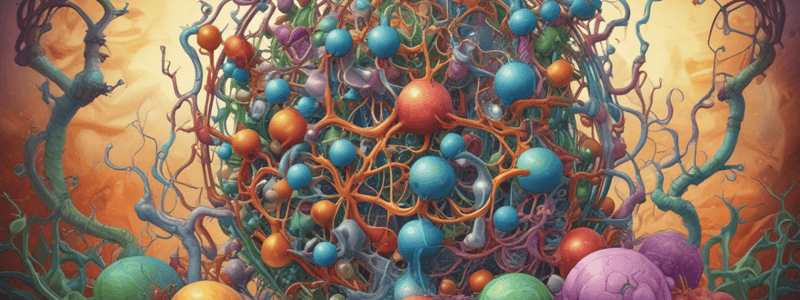Podcast
Questions and Answers
What type of bond is formed during the oxidation process?
What type of bond is formed during the oxidation process?
- Hydrogen bond
- Electrostatic bond
- High-energy bond (correct)
- Low-energy bond
The carbons in CO2 originate from pyruvate.
The carbons in CO2 originate from pyruvate.
False (B)
What is the function of the enzyme nucleoside diphosphate kinase?
What is the function of the enzyme nucleoside diphosphate kinase?
To convert NTPs in the cell, making GTP as good as ATP.
During the Succinyl-CoA Synthetase reaction, the thioester bond is phosphorylyzed, followed by phosphoryl transfer to _______________________, producing succinate plus GTP.
During the Succinyl-CoA Synthetase reaction, the thioester bond is phosphorylyzed, followed by phosphoryl transfer to _______________________, producing succinate plus GTP.
Match the following enzymes with their respective functions:
Match the following enzymes with their respective functions:
What is the role of the His residue in the active site of Succinyl-CoA Synthetase?
What is the role of the His residue in the active site of Succinyl-CoA Synthetase?
The citric acid cycle produces a net complete oxidation of glucose after two pyruvates go through the cycle.
The citric acid cycle produces a net complete oxidation of glucose after two pyruvates go through the cycle.
What is the result of the Succinate Dehydrogenase reaction?
What is the result of the Succinate Dehydrogenase reaction?
What is the role of the iron-sulfur center in aconitase?
What is the role of the iron-sulfur center in aconitase?
The carbon lost as CO2 in the isocitrate dehydrogenase reaction is originally from the carbons in acetyl-CoA.
The carbon lost as CO2 in the isocitrate dehydrogenase reaction is originally from the carbons in acetyl-CoA.
What is the function of the Mn2+ ion cofactor in isocitrate dehydrogenase?
What is the function of the Mn2+ ion cofactor in isocitrate dehydrogenase?
Aconitase also regulates ______________________ uptake and metabolism in the cell.
Aconitase also regulates ______________________ uptake and metabolism in the cell.
What is the type of reaction that occurs in the α-ketoglutarate dehydrogenase complex?
What is the type of reaction that occurs in the α-ketoglutarate dehydrogenase complex?
The α-ketoglutarate dehydrogenase complex has a similar structure and function to the pyruvate dehydrogenase complex.
The α-ketoglutarate dehydrogenase complex has a similar structure and function to the pyruvate dehydrogenase complex.
Match the following enzymes with their corresponding reactions:
Match the following enzymes with their corresponding reactions:
What is the role of the iron-sulfur center in the regulation of iron uptake and metabolism in the cell?
What is the role of the iron-sulfur center in the regulation of iron uptake and metabolism in the cell?
What is the effect of inhibiting isocitrate dehydrogenase on the citrate levels?
What is the effect of inhibiting isocitrate dehydrogenase on the citrate levels?
Citrate synthase is activated by product accumulation.
Citrate synthase is activated by product accumulation.
What is the role of succinyl-CoA in the citric acid cycle?
What is the role of succinyl-CoA in the citric acid cycle?
The aconitase reaction (Step #2) is _______________________
The aconitase reaction (Step #2) is _______________________
What is the function of the iron-sulfur center in the citric acid cycle?
What is the function of the iron-sulfur center in the citric acid cycle?
α-ketoglutarate dehydrogenase is a rate-controlling enzyme in the citric acid cycle.
α-ketoglutarate dehydrogenase is a rate-controlling enzyme in the citric acid cycle.
What is the effect of accumulated citrate on phosphofructokinase-1 in glycolysis?
What is the effect of accumulated citrate on phosphofructokinase-1 in glycolysis?
Match the following enzymes with their functions:
Match the following enzymes with their functions:
Flashcards are hidden until you start studying
Study Notes
Iron-Sulfur Center in Aconitase
- Iron-sulfur center acts in both substrate binding and catalysis (dehydration and hydration)
- Aconitase regulates iron uptake and metabolism in the cell
Isocitrate Dehydrogenase
- Isocitrate dehydrogenase is an oxidation coupled to a hydride transfer to NAD+
- The enzyme uses a Mn2+ ion cofactor, enhancing the electron withdrawing power of the carbonyl and facilitating decarboxylation
- Carbon lost as CO2 is not originally from carbons in acetyl-CoA
α-KG Dehydrogenase Complex
- α-ketoglutarate dehydrogenase complex performs oxidative decarboxylation, splits the carbon-carbon bond, releases CO2, and reduces NAD+ to NADH
- Has a structure similar to PDH complex and also works similarly
- Has E1, E2, E3 and coenzymes TPP, lipoyllysine, CoA, FAD, and NAD+
- The energy of the oxidation is conserved in the form of a thioester bond
Similar Reactions
- Thioester bond is a high-energy bond with very negative free-energy of hydrolysis
- α-KG dehydrogenase complex and PDH complex share similarities
Origin of Carbon Atoms in CO2
- The carbons in CO2 originate from oxaloacetate, not from pyruvate
- Net complete oxidation of glucose occurs after two pyruvates go through the citric acid cycle
Succinyl-CoA Synthetase
- Succinyl-CoA synthetase performs phosphorylysis of the thioester bond, followed by phosphoryl transfer to GDP, producing succinate plus GTP
- Transfer of phosphate is mediated by His residue in the active site
- GTP is as good as ATP, with free conversion of NTPs in the cell
Succinate Dehydrogenase
- Succinate dehydrogenase converts succinate to fumarate, with reducing power transferred to FAD
- FADH2 yields 1.5 ATP
- Rate controlling enzymes: citrate synthase, isocitrate dehydrogenase, and α-ketoglutarate dehydrogenase
Regulation of Activity
- Regulation of activity: activated by substrate availability, inhibited by product accumulation
- Allosteric inhibition or activation by other intermediates
Other Regulation Mechanisms
- Citrate synthase is also inhibited by succinyl-CoA
- α-ketoglutarate is an important branch point for amino acid metabolism
- Succinyl-CoA communicates the flow at this branch point to the start of the cycle
- Inhibition of isocitrate dehydrogenase leads to accumulation of isocitrate, pushing the equilibrium towards citrate
- Accumulated citrate leaves mitochondria and inhibits phosphofructokinase-1 in glycolysis
Studying That Suits You
Use AI to generate personalized quizzes and flashcards to suit your learning preferences.




